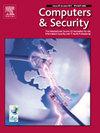Conditional entropy-based hybrid DDoS detection model for IoT networks
IF 5.4
2区 计算机科学
Q1 COMPUTER SCIENCE, INFORMATION SYSTEMS
引用次数: 0
Abstract
In a distributed denial-of-service (DDoS) attack, an attacker channelizes the resources of a botnet to launch denial of service attack on the victim. The increased use of IoT devices and dependence of users on e-services like online shopping and online payments have elevated the liability risks. The entropy provides a significant measure of randomness. The variation in entropy of traffic features determines the presence of abrupt traffic. This paper uses entropy and conditional entropy to achieve insights on data and feeds it to the proposed 2-stage detection approach for multi-class classification. The proposed model employs four classifiers for first hand classification. Further, stacking generalization-based second stage achieves the final detection process. The recently launched CIC IoT 2023 dataset is used to illustrate the findings of the study. The proposed approach produces an accuracy of 99.86%. Further, this paper utilizes relative entropy for the determination of deflection of traffic behavior between the attack and legitimate samples. Comparisons have been made among symmetric versions of information divergence, -divergence and Kullback–Leibler divergence along with, Hellinger distance and total variation distance. It is found that the information distance gives a better differentiation between the entropy of legitimate traffic and attack traffic. Significance Statement Entropy has been manipulated to define the nature of incoming traffic for any rule-based detection. This work explores the significance of conditional entropy for the ML-based detection of DDoS attacks in a recently launched IoT-based dataset. Additionally, the effectiveness of KL-divergence, information divergence, -divergence, Hellinger distance and total variation distance is compared for differentiating between legitimate traffic and attack traffic.
基于条件熵的物联网网络混合 DDoS 检测模型
在分布式拒绝服务(DDoS)攻击中,攻击者利用僵尸网络资源对受害者发起拒绝服务攻击。物联网设备使用的增加以及用户对网上购物和网上支付等电子服务的依赖提高了责任风险。熵是随机性的重要衡量标准。流量特征熵的变化决定了是否存在突然流量。本文利用熵和条件熵对数据进行深入分析,并将其输入到所提出的多类分类两阶段检测方法中。所提出的模型采用四个分类器进行第一手分类。此外,基于堆叠泛化的第二阶段实现了最终的检测过程。最近推出的 CIC IoT 2023 数据集被用来说明研究结果。所提出的方法准确率高达 99.86%。此外,本文还利用相对熵来确定攻击样本与合法样本之间的流量行为偏差。本文比较了对称版本的信息发散、ϕ-发散、库尔贝克-莱布勒发散以及海灵格距离和总变异距离。结果发现,信息距离能更好地区分合法流量和攻击流量的熵。意义声明 在基于规则的检测中,熵被用来定义输入流量的性质。本研究探索了条件熵对基于最近推出的物联网数据集的 DDoS 攻击的基于 ML 检测的意义。此外,还比较了 KL-发散、信息发散、j-发散、海林格距离和总变异距离在区分合法流量和攻击流量方面的有效性。
本文章由计算机程序翻译,如有差异,请以英文原文为准。
求助全文
约1分钟内获得全文
求助全文
来源期刊

Computers & Security
工程技术-计算机:信息系统
CiteScore
12.40
自引率
7.10%
发文量
365
审稿时长
10.7 months
期刊介绍:
Computers & Security is the most respected technical journal in the IT security field. With its high-profile editorial board and informative regular features and columns, the journal is essential reading for IT security professionals around the world.
Computers & Security provides you with a unique blend of leading edge research and sound practical management advice. It is aimed at the professional involved with computer security, audit, control and data integrity in all sectors - industry, commerce and academia. Recognized worldwide as THE primary source of reference for applied research and technical expertise it is your first step to fully secure systems.
 求助内容:
求助内容: 应助结果提醒方式:
应助结果提醒方式:


